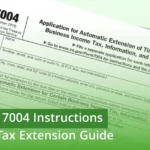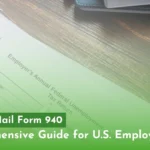
Running behind on your business return? IRS Tax Form 7004 gives you up to six extra months to file, but it doesn’t delay what you owe. This form applies to C corps, S corps, partnerships, and more. To qualify, you must submit a correct estimate, file by the original due date, and pay any balance due. Here, we’ll cover both general and specific IRS Form 7004 instructions, including when to use it, what information you’ll need, and how to e-file or mail your request to avoid late penalties.
What Is Form 7004?
The 7004 form is the official IRS application used to request an automatic extension of time. Commonly used to file business income and information returns. Businesses facing delays from incomplete documentation or internal processing issues can use it to their advantage. They get up to six months to avoid penalties for late submission and accurately file their federal return. Here’s an overview of Form 7004:
- Purpose: For extra time to file federal returns that report a business’s yearly income, expenses, and taxes, such as Forms 1120, 1120-S, 1065, and 1041.
- Federal Only: This extension covers federal tax filings. Most states require a separate extension request. So, check your state’s requirements as they need to be filed independently.
- Deadline Rules: To qualify, you must:
File the 7004 form by the original due date of the return
Provide a valid EIN or SSN
Estimate your total tax due and pay that amount - No Signature Processing: It can be processed faster if you e-file it today with Acct. Right, PLLCs help. Also, Form 7004 does not require a signature.
- Penalty Risk: This form extends only the filing deadline, not the payment deadline. Not paying estimated taxes on time can cause late payment penalties or incur interest.
Who Can File Form 7004?
The majority of the business entities can file Form 7004. For specifics, a business qualifies if it submits one of the following federal returns:
- C corporations (Form 1120)
- S corporations (Form 1120-S)
- Partnerships (Form 1065)
- Multi-member LLCs taxed as partnerships or corporations
- Trusts and estates (Form 1041)
- Certain foreign corporations and consolidated groups
Instructions to Fill Out Form 7004
Follow these steps to correctly complete Form 7004 and avoid errors or delays:
1. Start with Basic Info (Top of Form)
- Enter your business name (same as last year’s filing).
- Use the correct address (include suite, P.O. box, etc.).
- Add your Employer ID Number (EIN) or Social Security Number (SSN).
- If your address has changed, update it separately using Form 8822 or 8822-B.
2. Pick the Right Extension Code (Part I)
- Line 1: Choose the right code for the return you’re extending (e.g., 1120 for C Corps, 1065 for partnerships).
3. Fill Out Extension Details (Part II)
- Line 2: Check the box if you’re a foreign corporation with no U.S. office.
- Line 3: If you’re filing as a consolidated group, attach a list of all group members (name, EIN, address).
- Line 4: If your records are outside the U.S. and you’re requesting an extra extension, check the box and include a written statement.
- Line 5a-5b: If you’re not using a calendar year (or using a short year), enter start/end dates and explain why.
- Line 6-7: Estimate your total tax owed, subtract any prior payments or credits, and show the remaining balance due.
- Line 8: Remember, filing Form 7004 does NOT extend the time to pay. Pay estimated taxes now to avoid penalties. Some filers must pay electronically.
4. Do You Need to Sign?
- No signature is needed: If filed correctly, your extension is automatically granted unless the IRS later denies it.

Filing Methods & Where to File Form 7004
Choose your submission method; electronic filing is the fastest. Paper filings require attention to correct mailing addresses based on return type and location. Here’s a complete guide on how and where to mail Form 7004. Click to read.
Note: Use the IRS “Where to File Form 7004” chart for other return types and states.
Filing Deadlines and Extension Periods
To receive a Form 7004 extension, businesses need to file the form on or before the original due date of their federal return. The IRS grants up to six additional months to file (that’s the extensions businesses get). Keep in mind that the extension period given and due date depend on the entity type and tax year. Here is a breakdown of standard rules:
• C Corporations (Form 1120)
Calendar-year corporations need to file the form on or before April 15 (deadline). Filing Form 7004 by this date grants a six-month extension, which is October 15. Fiscal-year corporations need to file it by the 15th day of the fourth month (after their fiscal year ends).
• S Corporations (Form 1120-S)
In this, calendar-year filers have to file returns n or before March 15. A valid Form 7004 extension moves the deadline to September 15. Fiscal-year S corporations follow the 15th day of the third month after year-end.
• Partnerships and Multi-Member LLCs (Form 1065)
For calendar-year entities, the due date is March 15, with an extended deadline of September 15. Fiscal-year filers follow the same “15th day of the third month” rule.
• Trusts and Estates (Form 1041)
These filers receive a 5½-month extension. A trust with a calendar year-end of December 31 must file by April 15, extending to September 30.
• C Corporations with a June 30 year-end
These entities are granted a seven-month extension, not six.
All extension periods begin from the return’s original due date. Filing late or estimating tax incorrectly may result in penalties, even if the extension is approved. Therefore, get a team that does the work for you at Acct. Right, PLLC.
Filing Tips and Mistakes to Avoid
Before you file Form 7004, keep these critical points in mind:
- Payment isn’t extended: Filing this form does not extend your time to pay. Estimate and pay any tax due by the original return deadline to avoid penalties and interest.
- One form per return: You must file a separate Form 7004 for each business return you’re requesting an extension for. No blanket coverage.
- No confirmation from IRS: The IRS only contacts you if your extension is denied. No news means it’s accepted.
- Avoid penalties from timing issues: If you paper-file your return before the IRS processes the extension, you might get penalty notices anyway.
- Use the right form: Don’t use Form 7004 to extend Form 1041-A. Use Form 8868 instead.
Need Help Filing Form 7004?
Acct. Right, PLLC helps small business owners file accurate, on-time extension forms without the stress. From choosing the right extension code to making sure it’s filed properly online or by mail, we’ve got your back.
Let’s file it right. Book a free consultation today.
Form 7004 instructions can be confusing, but the process itself is simple. Just estimate and pay your taxes by the original due date, then file an accurate extension. The IRS doesn’t give second chances, so file on time and keep records. Double-check the address for 7004 if mailing, & confirm IRS acceptance online.
Need help with where to file extension 7004, choosing the right address for 7004, or avoiding mistakes? Acct Right PLLC handles the full process. We do e-filing, tax estimation, compliance, and follow-up. Let our professionals take care of it, so you don’t miss a thing. Book now through acctrightpllc.com.




